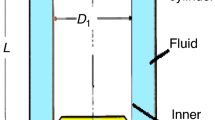Abstract
Seals are extremely useful devices to prevent fluid leakage. We present an effective-medium theory of the leak rate of rubber seals, which is based on a recently developed contact mechanics theory. We compare the theory with experimental results for seals consisting of silicon rubber in contact with sandpaper and sand-blasted PMMA surfaces.
Similar content being viewed by others
References
R. Flitney, Seals and Sealing Handbook (Elsevier, 2007)
M. Mofidi, B. Prakash, B.N.J. Persson, O. Albohr, J. Phys.: Condens. Matter 20, 085223 (2008)
B.N.J. Persson, O. Albohr, U. Tartaglino, A.I. Volokitin, E. Tosatti, J. Phys.: Condens. Matter 17, R1 (2005)
B. Lorenz, B.N.J. Persson, EPL 86, 44006 (2009)
B.N.J. Persson, O. Albohr, C. Creton, V. Peveri, J. Chem. Phys. 120, 8779 (2004)
B.N.J. Persson, C. Yang, J. Phys.: Condens. Matter 20, 315011 (2008)
B.N.J. Persson, J. Chem. Phys. 115, 3840 (2001)
B.N.J. Persson, Phys. Rev. Lett. 99, 125502 (2007)
B.N.J. Persson, Surf. Sci. Rep. 61, 201 (2006)
B.N.J. Persson, Eur. Phys. J. E 8, 385 (2002)
B.N.J. Persson, F. Bucher, B. Chiaia, Phys. Rev. B 65, 184106 (2002)
C. Yang, B.N.J. Persson, J. Phys.: Condens. Matter 20, 215214 (2008)
B.N.J. Persson, J. Phys.: Condens. Matter 20, 312001 (2008)
The contact mechanics model developed in refs. JCPpers,PerssonPRL,PSSR,P1,Bucher,YangPersson,PerssonJPCM takes into account the elastic coupling between the contact regions in the nominal rubber-substrate contact area. Asperity contact models, such as the “standard” contact mechanics model of Greenwood-Williamson GW, and the model of Bush Bush, neglect this elastic coupling, which results in highly incorrect results Carlos,Carbone, in particular for the relations between the squeezing pressure and the interfacial separation Lorenz
J.A. Greenwood, J.B.P. Williamson, Proc. R. Soc. London, Ser. A 295, 300 (1966)
A.W. Bush, R.D. Gibson, T.R. Thomas, Wear 35, 87 (1975)
C. Campana, M.H. Müser, M.O. Robbins, J. Phys.: Condens. Matter 20, 354013 (2008)
G. Carbone, F. Bottiglione, J. Mech. Phys. Solids 56, 2555 (2008)
B. Lorenz, B.N.J. Persson, J. Phys.: Condens. Matter 201, 015003 (2009)
D. Stauffer, A. Aharony, An Introduction to Percolation Theory (CRC Press, 1991)
See paper F in: F. Sahlin, Lubrication, contact mechanics and leakage between rough surfaces, PhD thesis (2008)
Figure pic.Az.Azdz.rough(a) is schematic as in reality the contact islands at high enough magnification are fractal-like, and decreasing the magnification results in more complex changes than just adding strips (of constant width) of contact area to the periphery of the contact islands. However, this does not change our conclusions.
In ref. YangPersson the probability distribution of interfacial separations 〈δ(u−u(x))〉 as obtained from Molecular Dynamics calculations for self-affine fractal surfaces (with the fractal dimension D f = 2.2) was compared to the distribution of separations obtained from u 1(ζ). The former distribution was found to be about a factor of two wider than that obtained from u 1(ζ). This is consistent with the fact that u 1(ζ) is already an averaged separation and indicate that in this case α ≈ 0.5.
D. Bruggeman, Ann. Phys. Leipzig 24, 636 (1935)
V.N. Ambegaokar, B.I. Halperin, J.S. Langer, Phys. Rev. B 4, 2612 (1971)
A.G. Hunt, Percolation Theory for Flow in Porous Media (Springer, New York, 2005)
Z. Wu, E. Lopez, S.V. Buldyrev, L.A. Braunstein, S. Havlin, H.E. Stanley, Phys. Rev. E 71, 045101(R) (2005)
F. Bottiglione, G. Carbone, L. Mangialardi, G. Mantriota, J. Appl. Phys. 106, 104902 (2009)
S. Kirkpatrick, Rev. Mod. Phys. 45, 574 (1973)
Author information
Authors and Affiliations
Corresponding author
Rights and permissions
About this article
Cite this article
Lorenz, B., Persson, B.N.J. Leak rate of seals: Effective-medium theory and comparison with experiment. Eur. Phys. J. E 31, 159–167 (2010). https://doi.org/10.1140/epje/i2010-10558-6
Received:
Published:
Issue Date:
DOI: https://doi.org/10.1140/epje/i2010-10558-6




